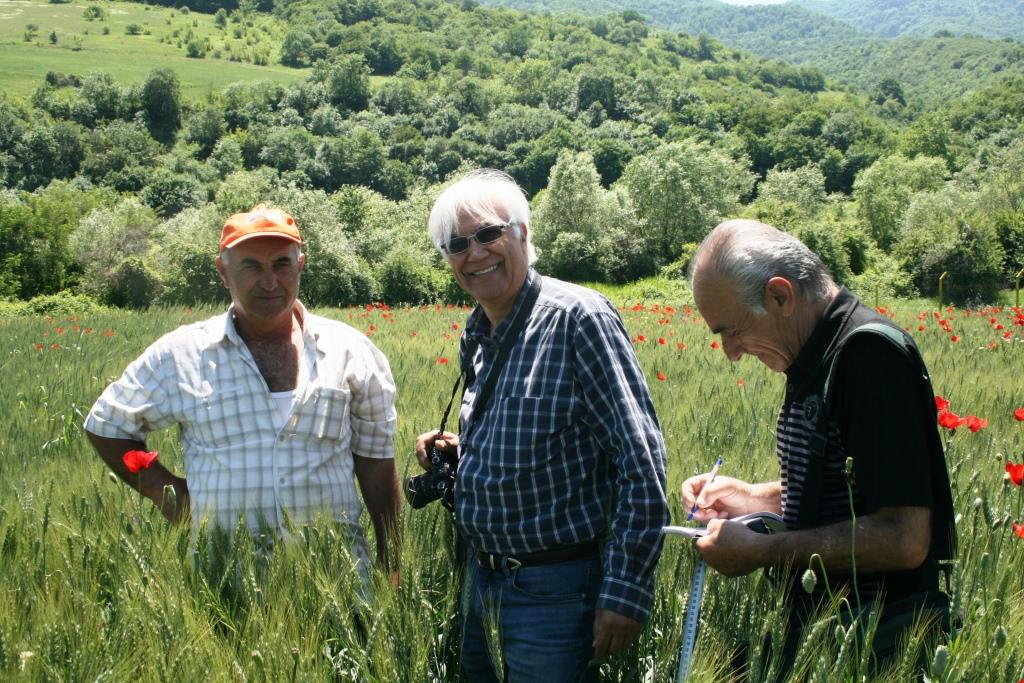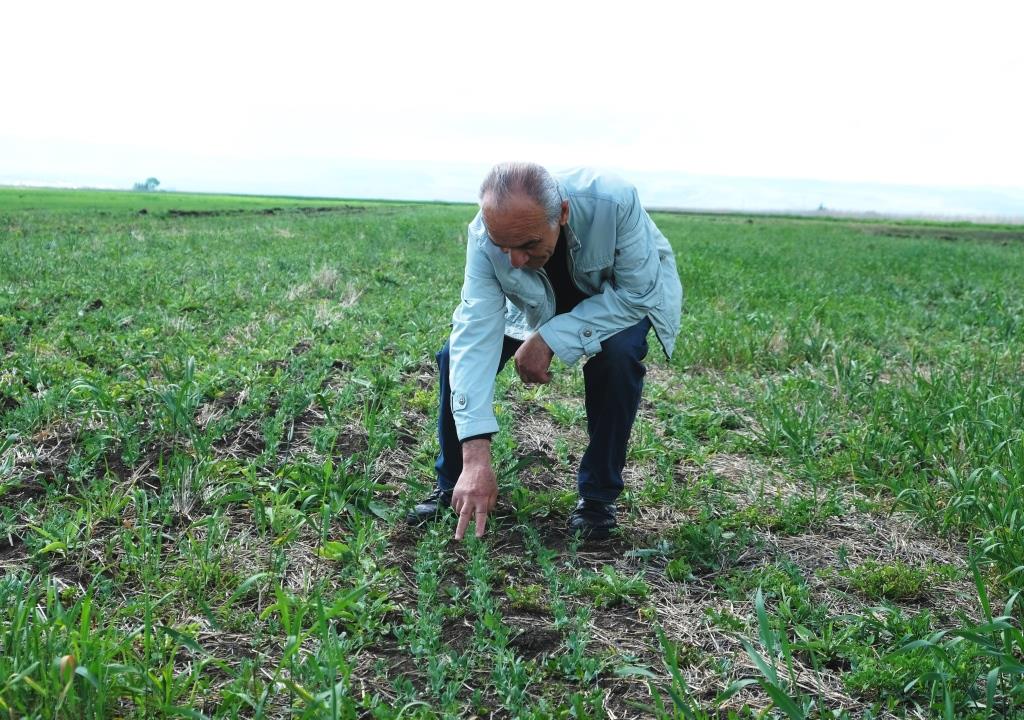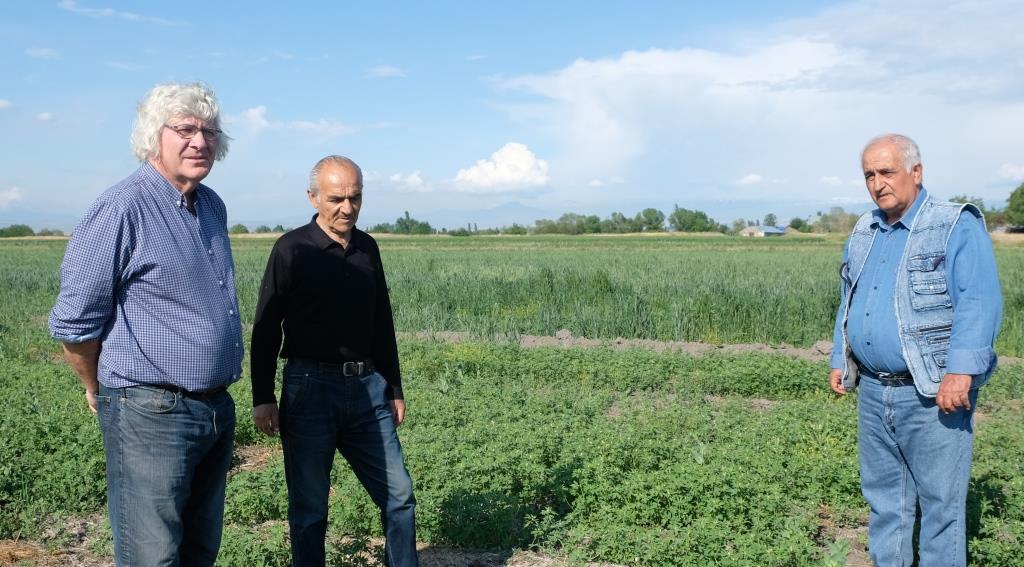
“Pity the nation that is full of beliefs and empty of religion.
Pity the nation that wears a cloth it does not weave and eats a bread it does not harvest.”
― Gibran Kahlil Gibran, from The Garden of The Prophet
On this, the thirtieth anniversary of its founding in Fresno, California, the Armenian Technology Group, Inc. (A.T.G.), through its office in Armenia, has officially registered its latest high yielding, high quality wheat seed variety with Armenia’s Plant and Seed Inspection and Quality Control Service. The seed was bestowed the name ARTHAZAR in memory of the founding chairman of the group, Dr. Arthur O. Hazarabedian, D.V.M. (1930-2003).
The selection of the seed is the result of years of research during which A.T.G.’s staff in Armenia set up trial plots in numerous locations throughout Armenia. The idea was to ensure that each wheat seed variety was suitable for planting in the various growing or climate zones of Armenia and, most importantly, would secure larger quantities of harvest per acre, while generating higher incomes for the growers.
“This is simply our gesture to express our gratitude to Dr. Hazarabedian and his group who, despite having their own different professions, focused their attention on the most vulnerable segment of our economy,” stated the originator of the seed-naming concept, Gagik Mkerchyan, director of the A.T.G. Foundation in Armenia, who was spearheading the project. “The aims that Dr. Hazarabedian initiated in Armenia during the early years of independence saved thousands of lives, to say the least. They continue to inspire the rebuilding of the country’s Seed Bank,” Mkerchyan added.
“We now germinate the seed in our country and supply local grain growers with the highest quality seed available for Armenia’s climate. Needless to say, over the years we experimented with some 496 seed varieties, several of which already have been registered and start with A.T.G. acronyms. These are in circulation but, certainly, we had to select the best seed for the legacy of Dr. Hazarabedian,” said Mekhitar Grigoryan, head agronomist of the group.

“This is homage to the vision that Art and his colleagues had for the people of Armenia. By sharing ARTHAZAR wheat seed with the grain growers we are spreading Art’s spirit and hope in Armenia’s heartland. We congratulate our staff for their dedication in continuing the organization’s mission,” said Varoujan Der Simonian, Executive Director of A.T.G.
For a landlocked country like Armenia, food security is an integral part of national security. This vital issue becomes more apparent, when Armenia’s geo-economic situation is taken into account. Since its inception in 1989, the founding members of the California based non-profit organization, the Armenian Technology Group, Inc. (A.T.G.), rebuilt Armenia’s agricultural infrastructure by placing their greatest emphasis on securing the country’s wheat consumption needs.
While Armenia was part of the Soviet Union, some 70 percent of its grain consumption was being imported from Ukraine and Russia. Independence and the economic blockade, since then, made such transactions much more difficult and costly. Dependence on other countries for grain to feed its own people made Armenia much more vulnerable, while affecting, at the same time, its overall economic and political bargaining strength.
Reflecting on 30 years of service to the people of Armenia, Der Simonian said, “We give homage to all the A.T.G. board members and technical advisors—Dr. Arthur Hazarabedian, D.V.M., Dr. Robert Bushnell, Dr. Leon Garoyan, Dr. Jack Morse, Don Tounjes, Monte Bell, Roger Benton with an onlooker, and the local agronomist, Mekhitar Grigoryan, who planted the first wheat and alfalfa seed fields and trial plots near the epicenter of the earthquake-devastated city of Spitak.”

The support of U.S. government entities was substantial during subsequent years. Through such means, in 1995, world experts in wheat seed production—Dr. Warren Kronstad, Dr. Curt De Louche and Dr. Richard Newberg, who made significant contributions to India’s Green Revolution – were able to draft a strategic map for A.T.G. to follow, thereby helping Armenia, too, increase wheat production. One of the key components of the map insured the sustainability of a program. This meant being able to propagate the breeder seed in consecutive years, thereby creating a germinating foundation that could be registered and certified. This would result in a common seed that made possible, later, a harvest by grain growers that could, again, be sown, for subsequent harvesting, milling or general consumption.
Thus, establishing a seed bank was a vitally important component of establishing sustainable domestic seed production, one that could meet local climatic requirements and planting needs. Over the past two decades A.T.G. built a seed inventory reserve. However, several times, due to seed shortage or drought, the Group distributed its seed supplies to the growers to sow on their farms. Currently, A.T.G. is, again, in the process of re-building Armenia’s Seed Bank—with locally generated seed.
Certainly, the people of Armenia have always appreciated the support received from friendly countries, during natural disasters or economic blockade. Nevertheless, in order for a country to sustain economic and social stability—particularly during a crisis—it must be in the position of producing a substantial amount of its main food supply on its own—and be capable of feeding its own population.
As the seed project evolved, A.T.G. embarked on an applied science methodology by setting up trial plots in seven growing zones in Armenia and Artsakh. The organization took it upon itself to carry out a continuing Research & Development process. It selects the most suitable and highest yielding seed varieties, thereby creating the potential of continuing to secure the highest economic return on investment. Thus, trial plots came to be scattered in up to 14 locations each year. Over the past 30 years some 496 select wheat, alfalfa, corn and other seed varieties, some also obtained from the International Maize and Wheat Improvement Organization (CIMMYT), International Center for Agricultural Research in the Dry Areas (ICARDA) and other entities were tested. Only after selecting the most suitable ones were these varieties made available to grain growers. Trial plots became, in this way, the foundation upon which the Seed Multiplication Program was launched. The US government was a major contributor to this endeavor.
A Seed Producers Association was formed. It came to be composed of A.T.G.-affiliated farmers. Association members were trained by A.T.G. technical advisors to become specialized in propagating seed. Their continuous education included participating in the more than 285 training seminars and field demonstration that A.T.G. carried out over the past 30 years.
“We follow the process by conducting extensive trials of varieties over a two year period. We carry all the risks, and only after ensuring the best seed varieties—varieties suitable for producing the best results in a given region—only then do we make the seeds available to Seed Producing Association members.” stated Grigoryan, who remembered fondly working with the founding members in planting the first fields.
Sadly, at one time, a lack of appreciation for the advantage of securing Armenia with its own domestically produced high yielding seeds, moved the staff of the Tigran Sargsyan Administration to import and distribute large quantities of non-tested and poor quality wheat seed varieties from abroad to Armenian grain growers. These, subsequently, caused a major economic loss to the farmers and to the country.
Maintaining quality control and a high industry standard have been crucial for the growth of a healthy and sustainable seed production program in the Republic of Armenia. In 2002, A.T.G. had initiated and funded an independent quasi-government body of Seed Inspection and Quality Control. The idea was twofold: First, to create a systemic structure that would oversee the seed production in the country and, thereby, ensure that industry standards continued to be met — standards, by which grain growers would be offered quality seeds suitable for planting in their growing zones. Second, to provide a functioning seed inspection service. Issuing phytosanitary certificates for domestically produced products would enhance the country’s standing in the international market and build trust and credibility—adhering, at the same time, to international regulations and standards. The goal and, ultimately, the reward, would be opening new market opportunities for Armenian products.
“With the official registration of the new ARTHAZAR wheat seed variety, we are pleased to report, the Seed Inspection and Quality Control Service is functioning,” said A.T.G President Dr. James Reynolds. “Once our office makes the new variety available to the local grain growers, we anticipate it will generate higher production yield and increase farm family income.”




Be the first to comment